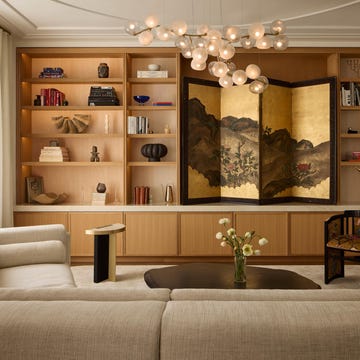This home has no formal front door. To enter, you descend a staircase that leads you to a terrace around the side of the property, away from the street, where you are encouraged to walk straight into the kitchen to be met by a monumental concrete structure that’s part dining table, part island. ‘The idea is that you slide the doors back, grab a glass of wine and start talking,’ says architect Raúl Sánchez.
The clients are close friends of his, and their love for entertaining inspired this creative choice. There’s a generosity to this first impression of the home, ushering guests straight to its heart, but the decision was also led by the landscape. The building is turned away from the road and towards the valley – the focus being the views through the treetops to the small town of Sant Cugat del Vallès below.
This vista was hard won, though, as the dramatically steep nature of the plot made it a uniquely tricky build. Jutting out from the hillside, the house rests with great poise on four concrete legs: ‘It looks like a little animal, ready to jump at any moment,’ says Raúl. ‘The structure is really complex,’ he continues, ‘but the concept was not to highlight that – rather, to make it almost disappear.’
What's everyone reading?
Inside, the architectural feat allowing it to rest on its perch is not apparent at all. The interior is open plan, with no pillars or columns, just a central core containing the bathroom, pantry and staircase.
The one reminder of the rocky outcrop can be found at the start of the spiralling steps. Inspired by the Italian architect Carlo Scarpa (who would often make the first step a little different when designing staircases), Raúl has placed a stone excavated from the site at the bottom of this triple-height flight.
‘It entreats you to approach – it’s like an invitation,’ he explains, adding that the design is monumental (playfully geometric, it begins enclosed within a square and arrives at the rooftop above through a circular opening), so its beginning had to be just as special.
Colour throughout is minimal, as are the furnishings – just a few pieces by mid-century Spanish designers. Where that changes is on the façade. For this, Raúl chose a terracotta hue that, he says, ‘was similar to the colours of the ground around but, at the same time, has its own personality. It’s an earthy shade, but not from this place, so there’s a kind of a strange familiarity.’
It’s now been five years since the start of this complex project, and Raúl enjoys visiting as a friend rather than architectural lead. Beers and barbecues on the roof terrace allow time to reflect on what has changed (the owners now have a one-year-old daughter) and what works so well.
‘Even now, they still call me if they want to put a plant anywhere, asking if I think it will look nice,’ he says, amused but clearly pleased to still be a part of a place that was made so uniquely for his clients – and is also a part of him. raulsanchezarchitects.com


















